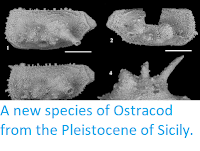Ostracods are small Crustaceans which conceal their bodies between two large valves in a bodyplan convergent with the unrelated Bivalve Molluscs and Brachiopods. They have an extensive fossil record, beginning in the Late Cambrian, and are probably the most abundant fossil Crustaceans, largely due to their small size and abundant natures. The largest Ostracods reach about 3 cm in length, but most species are under 3 mm. Due to their ubiquitous nature in marine and many freshwater ecosystems, and the distinctive patternation on the shells of many Ostracods, which makes species identification relatively easy, Ostracods are frequently used in biostratigraphy (the use of fossils to date rocks and establish sequences in rock formations).
Although much less diverse than marine Ostracods, there are still about 2300 species of recent freshwater Ostracods, arranged into 270 genera in 16 families. The largest family of freshwater Ostracods is the the Cyprididae, which is split into 24 subfamilies, the most species-rich of which is the Cypridopsinae, which contains 22 genera of Ostracods.
In a paper published in the journal Zookeys on 9 December 2021, Agata Szwarc of the Laboratory of Biosystematics and Ecology of Aquatic Invertebrates at the University of Gdansk, Koen Martens of the Royal Belgian Institute of Natural Sciences and the Department of Biology at Ghent University, and Tadeusz Namiotko, also of the Laboratory of Biosystematics and Ecology of Aquatic Invertebrates at the University of Gdansk, describe two new species of Cypridopsine Ostracods from freshwater ecosystems in Southern Africa.
The first new species described is placed in the genus Potamocypris, and given the specific name meissneri, in honour of the Polish ornithologist Włodzimierz Meissner, for his unrelenting support in the collection of ostracods from all over the world. The genus Potamocypris has a global distribution with currently contains 46 species, although only ten of these have been described from sub-Saharan Africa, and only five from Southern Africa. These Ostracods have asymmetric valves, with the right overlapping the left, spatula-shaped distal palp segments on their maxillulae, and tapering caudal rami (tail spikes).
Potamocypris meissneri is described from a series of female specimens collected from a small temporary open pan (flat area of land prone to seasonal flooding) near the village of Ganalaagte in North-West Province, South Africa. These are roughly ovoid Ostracods with rounded dorsal surfaces and extremities and slightly concave ventral margins. They reach 512-526 μm in length and 305-306 μm in height. The males of this species are unknown.
The second new species is placed in the genus Sarscypridopsis and given the specific name harundineti, which derives from the Latin 'harundinetum' meaning 'Reed-bed', which is the meaning of the name of the town Maun in Botswana, which is close to the sites where the species was found. The genus Sarscypridopsis has a largely Southern African distribution, with 13 of the 17 known species described from South Africa. This genus also has asymmetric valves, with the right overlapping the left, but the terminal segment of the maxillular palp is cylindrical and the base of the caudal ramus is triangular.
Sarscypridopsis harundineti is described from a series of specimens collected from locations on the floodplains south of the Okavango Delta in Botswana, including the grassy shore of seasonal pond, a temporary channel, and flooded swamp and grassland near Maun, Lake Ngami, and the Thamalakane River. The anterior and posterior margins of the carapace of this species are nearly symmetrically rounded, the dorsal margin almost evenly rounded. The right valve overlaps the left, except at the dorsal margin, where the left overlaps the right. The antennae of this species have long swimming setae and a bulbous sensory organ.
See also...



Follow Sciency Thoughts on Facebook.
Follow Sciency Thoughts on Twitter.





